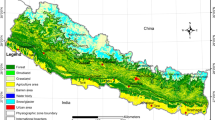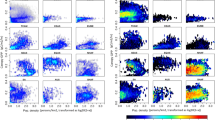Abstract
This paper presents data on the localization and number of forest fires that occur in the Arctic zones of the Krasnoyarsk Territory, as well as the possible causes of their occurrence. It is established that the main cause of forest and landscape fires are natural phenomena. A database of data normalized in a certain way about the factors shaping the occurrence of natural forest and landscape fires has been formed. The practice of connectionist algorithms, a forecasting model has been developed, and, based on data on forest and landscape fires in the Krasnoyarsk Territory; a model has been evaluated for using the model to predict fires in 2018. In order to compile a forecast of forest and landscape fires for 2019 in the Arctic zones of the Krasnoyarsk Territory using the connectionist algorithms, an optimal neuroarchitecture was chosen, which allows long-term time series forecasting.








Similar content being viewed by others
Explore related subjects
Discover the latest articles, news and stories from top researchers in related subjects.References
Antonov V, Tarkhov D, Vasilyev A (2018) Unified approach to constructing the neural network models of real objects. Part 1. Math Methods Appl Sci 41(18):9244–9251. https://doi.org/10.1002/mma.5205
Bedia J, Herrera S, Gutiérrez JM, Benali A, Brands S, Mota B, Moreno JM (2015) Global patterns in the sensitivity of burned area to fire-weather: implications for climate change. Agric For Meteorol 214–215:369–379. https://doi.org/10.1016/j.agrformet.2015.09.002
Carlini N, Wagner D (2017) Towards evaluating the robustness of neural networks. In: Paper presented at the proceedings—IEEE symposium on security and privacy, pp 39–57. https://doi.org/10.1109/sp.2017.49
Catalão J, Mariano S, Mendes V, Ferreira L (2005) An artificial neural network approach for day-ahead electricity prices forecasting. In: 6th WSEAS international conference on neural networks, USA, Stevens Point, pp 80–83
Chernykh AK, Nefedyev SA, Bardulin EN, Andreev VP, Stashevskaya OV (2018) Management of rectification of the consequences of an emergency situation. Int J Eng Technol (UAE) 7(3.14 Special Issue 14):276–282
Chuchuyeva IA (2010) Prognozirovaniye vremennykh ryadov pri pomoshchi modeli ekstrapolyatsii po vyborke maksimal’nogo podobiya. Nauka i sovremennost’: sbornik materialov Mezhdunarodnoy nauchno-prakticheskoy konferentsii, Novosibirsk 187–192
Didenko NI, Skripnuk DF, Kikkas KN, Sevashkin V, Romashkin G, Kulik SV (2018a) Innovative and technological potential of the region and its impact on the social sector development. In: Paper presented at the international conference on information networking, 2018-January, pp 611–615. https://doi.org/10.1109/icoin.2018.834319
Didenko NI, Klochkov YS, Skripnuk SD (2018b) Ecological criteria for comparing linear and circular economies. Resources 7(3):48. https://doi.org/10.3390/resources7030048
Galyautdinova AR, Sedova JS, Tarkhov DA, Varshavchik EA, Vasilyev AN (2019) Comparative test of evolutionary algorithms to build an approximate neural network solution of the model boundary value problem. Stud Comput Intel 799:67–76. https://doi.org/10.1007/978-3-030-01328-8_5
Golovko VA (2000) Neyronnyye seti: obucheniye, organizatsiya i primeneniye. IPRZHR, Moskva
Grebnev YAV, Yarovoy AV (2018) Monitoring i prognozirovaniye pavodkov na territorii Krasnoyarskogo kraya c ispol’zovaniyem neyrosetevykh algoritmov. Nauchno-analiticheskiy zhurnal « Sibirskiy pozharno-spasatel’nyy vestnik » , 3:13–16
Guseva AI, Malykhina GF, Nevelskiy AS (2019) Neural network based algorithm for the measurements of fire factors processing. Stud Comput Intel 799:160–166. https://doi.org/10.1007/978-3-030-01328-8_17
http://zakon.krskstate.ru/doc/54526. Accessed 18 Feb 2019
Khaykin S (2006) Neyronnyye seti: polnyy kurs. Moskva: OOO « I. D. Vil’yams»
Lazovskaya T, Tarkhov D (2016) Multilayer neural network models based on grid methods. In: Paper presented at the IOP conference series: materials science and engineering 158(1), p 012061. https://doi.org/10.1088/1757-899x/158/1/012061
Lozhkin V, Tarkhov D, Timofeev V, Lozhkina O, Vasilyev A (2016) Differential neural network approach in information process for prediction of roadside air pollution by peat fire. In: Paper presented at the IOP conference series: materials science and engineering 158(1), p 012063. https://doi.org/10.1088/1757-899x/158/1/012063
Malykhina GF, Guseva AI, Militsin AV, Nevelskii AS (2017) Developing an intelligent fire detection system on the ships. In: Paper presented at the CEUR workshop proceedings 2064, pp 289–296
Martynov OV (2011) Kontseptsiya sistemy prognoza prirodnykh katastrof i prakticheskiye rezul’taty poluchennyye na osnove apparatov nelineynoy fiziki. Nelineynyy mir. Moskva 21–22
Moskvichev VV, Shokin YUI (2012) Antropogennyye i prirodnyye riski na territorii Sibiri. Vestnik Rossiyskoy akademii nauk 2:131–140
Naidenova X, Parkhomenko V, Curbatov SA (2017) Neural-network like logical-combinatorial structure of data and constructing concept lattices. In: Paper presented at the CEUR workshop proceedings 1921, pp 62–76
Solomkin AV (2011) Kratkosrochnoye prognozirovaniye potrebleniya elektroenergii s pomoshch’yu neyrosetevykh metodov. Elektronika i informatsionnyye tekhnologii 1:3–5
Tarkhov DA, Migovan MA, Ivanenko KA, Smirnov SA, Kobicheva AM (2019) The problem of solution restoration by measurements for the laplace equation. Adv Intel Syst Comput 850:450–455. https://doi.org/10.1007/978-3-030-02351-5_51
Volchek AA (2010) Neyrosetevyye sredstva prognozirovaniya dlya kontrolya pavodka/A.A. Volchek. Materialy Materialy Mezhdunarodnoy nauchno-prakticheskoy konferentsii « Obespecheniye ekologicheskoy bezopasnosti — put’ k ustoychivomu razvitiyu Kazakhstana » , 23–24 fevralya 2010. Taraz: « Senim » , pp 83–16
Xu S, Liu K, Li X (2019) A fuzzy process neural network model and its application in process signal classification. Neurocomputing 335:1–8. https://doi.org/10.1016/j.neucom.2019.01.050
Yuan C, Zhang Y, Liu Z (2015) A survey on technologies for automatic forest fire monitoring, detection, and fighting using unmanned aerial vehicles and remote sensing techniques. Can J For Res 45(7):783–792. https://doi.org/10.1139/cjfr-2014-0347
Ziniakov VY, Gorodetskiy AE, Tarasova IL (2016) Control of vitality and reliability analysis. Stud Syst Decis Control 49(2016):193–204. https://doi.org/10.1007/978-3-319-27547-5_18
Acknowledgements
The research carried out with the financial support of the grant from the Program Competitiveness Enhancement of Peter the Great St. Petersburg Polytechnic University. The article is prepared in the frameworks of the research net “Innovation development of Russian Arctic regions and economic sectors”, “National Arctic Scientific-Educational Consortium” association. We are thankful to the team of the Center of Academic Writing of Tyumen State University, Zhuravleva Nadezhda and Valeria Evdash who lent a professional support in preparing this manuscript.
Funding
The research carried out with the financial support of the grant from the Program Competitiveness Enhancement of Peter the Great St.Petersburg Polytechnic University, Project 5-100-2020.
Author information
Authors and Affiliations
Corresponding author
Additional information
Publisher's Note
Springer Nature remains neutral with regard to jurisdictional claims in published maps and institutional affiliations.
Rights and permissions
About this article
Cite this article
Grebnev, Y., Moskalev, A., Vershkov, A. et al. The practice of connectionist model for predicting forest fires in the Arctic zones of the Krasnoyarsk Territory. Int J Syst Assur Eng Manag 11 (Suppl 1), 1–9 (2020). https://doi.org/10.1007/s13198-019-00786-w
Received:
Revised:
Published:
Issue Date:
DOI: https://doi.org/10.1007/s13198-019-00786-w




